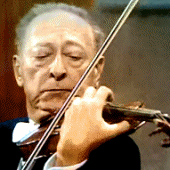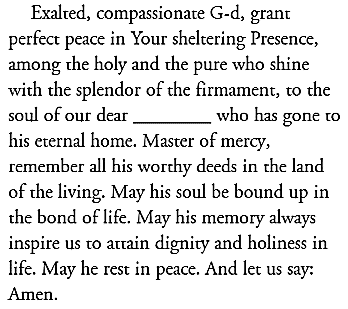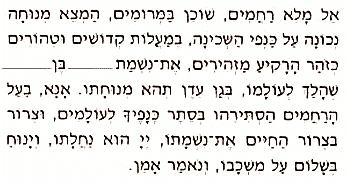![]()
| Roots and ethos of the Heifetz muse | |
|
Cantorial Chant The traditional way of singing the sacred prayers in the synagogue is called “hazanut” or cantorial singing. The style is that of florid melodious intonation and cantillation of the scriptures, requiring extensive vocal agility (trills, portamenti, mordents, acciaccaturi, vibrato, falsetto, etc). These ornamental flourishes impart the special flavor characteristic of the traditional Jewish chant and aim to convey the emotional content to the listener. The emotional message is expressed through the manner in which the chant is performed, seemingly mirroring (yet often devoid of - this is important to realize) the cantor’s own emotional involvement – more of which later. After the scripture cantillation, the most important section of the Jewish liturgy is the sequence of benedictions which is known as the Amidah ("standing prayer"). This is a most impressive sequence, both aurally and visually and no child, including a five-year-old Heifetz, can fail to be extremely impressed by the sight of the entire congregation raising up as one and repeating the cantor’s lines, chorus-like, in the benediction. It is bound to leave a lasting impression on any child who had ever attended such a service at a fragile age (as, for example, it used to impress me as well). The Rabbis in the synagogues are those who conduct the sermons and religious service while the Cantors lead by chanting the sacred scripts. The Jewish chant varies by location and it is further divided into Ashkenazi and Sepharadi styles which differ in their melodic content. The Sepharadi is influenced by Oriental and Arabic ornaments while the Easter European and that of the Pale of Settlement is influenced by the Russian ethos. Pure Jewish chants do not exist as such and whatever did exist in ancient times is long lost by now. Although it mostly recites the Torah, the melodic content is occasionally mixed with elements of secular Jewish motifs, which eventually became part of the Jewish musical tradition. Notably, the cantors also fulfilled religious duties outside the synagogues, such as funeral services. Funeral chants differ from those of the Torah reading, reciting as they do traditional prayers culminating in the Kaddish and Yzkor ("El Maleh Rahamim", etc.), the intonation to the remembrance of the deceased. The Jewish chant, including the cantorial cantillation, is essentially a lamentation. This does not exclude rhythmic and faster songs (ne'ymot), sung at weddings, bar-mitzvas and other ceremonial occasions. Just like with any other minorities, from the slow “flamenco” and the “cante hondo” of the Spanish gypsies to the czardash of the Hungarian and the “doina” of the Romanian gypsies, the Jewish cantilena is first and foremost a lament of, and for, the soul. Its ethos depicts the constant tension and discrepancy between the harsh daily reality to that which the soul is yearning for. The various modal differences would not have escaped the attention of an extraordinary musically-sensitive ear like Heifetz’s, and once this eternal tension is sensed and assimilated, it would become thereafter the core of his artistic expression. Different prayers call for varying congregation unisons but the cantorial melodic line itself would usually consist, and still does, of relatively uniform intonation around the dominant chord. It then usually concludes in a descent to the major third interval, or to the tonic. The chromatic intervals survived in the Jewish chant as a reminder of the Oriental influence of dividing a pitch interval into subintervals. This is most evident in the intricacies of some of the vocal embroideries and ornaments, often so elaborate as to intimidate even a seasoned singer ("There were cantors and there were cantors..."). During the early part of the 20th century, some of the more vocally gifted cantors went on to acquire world fame and a number of them have successfully crossed the line into the operatic world. This predominantly coloratura character of the cantorial music would imprint itself in Heifetz’s ear and would likely contribute to his life-long fascination and love affair with the opera. Below is a short potpourri of cantorial examples. Note the embellishments mentioned above - the trills, sobbing-choking voice, falsetto, grace notes, slides, etc. These examples reaffirm the germane tradition and the inspirational bedrock for such well-known compositions as Hebrew Melody, Hebrew Lullaby, Nigun, Kaddish, Abodah, etc. They are all embedded in the Jewish cantorial tradition that is the make-up of the Jewish chants, the secular and the sacred intonation alike. They are also the generations-old zmirot and shyrey eres - the centuries-old slow, soothing laments and lullabies, sang by mothers to their infants. The distinctive feature of the Jewish cantillation, like that of many minorities who draw their inspiration from folk songs, is the canticle-vocalistic characteristic. The cantillation is performed almost exclusively during congregation (after all, music is a communication medium) which fulfills many a role, among others, to induce an emotional state in the audience. Several tried and trusted vocalistic elements and techniques are invoked by the cantor to achieve his aim. Causing and bringing the congregation to emote is done in a controlled manner and this can (only) be attained when the cantor himself is in full control of his own emotional state, craft and performance. These vocalistic pyrotechnics and ornaments may well project the impression that the cantor is in a high emotional state himself, whereas in fact he may be nowhere near such a state. Being able to bring the congregation to emote in response to his lamentation does not mean that he experiences a similar state. I firmly believe that Heifetz could not have failed to sense the imparity between the altered emotional state of the audience and that of the controlled, cool stance of the cantor. The expressive elements which adorn the cantor’s ostensibly emotive delivery are but tools of inducing emotion in the congregation. The apparent paradox is that as much as the cantor seems to emote, whimper and wail in his lamentation, he is in fact in full control of his emotions and vocal manipulations. By astutely invoking the required vocal ornaments, his chant turns into an incantation which induces the desired effect in his audience. To illustrate the point, a recent ad for a cantor's position in a large and well-known synagogue, highlights the desired elements requirement for the job:
Perhaps nowhere is the cantor's
emotion-inducing ‘manipulation’ more evident than in the intonation of the
Kaddish, the prayer-lament after the dead, where the desired effect
is to invoke the sorrow and grief of the congregation for the
irreversible loss, and allow them to weep and mourn after the departed.
The gathering around the grave constitutes an act of emotional support
for the bereaved family, where the entire congregation is cued by the
cantor and induced into communal mourning. The Jewish sacred music
aspires therefore to minimize the performer's emotional turmoil and
involvement, attempting instead to induce the emoting process in the
audience. It is a way of bringing about a brief, but nevertheless
yearned for, needed relief in the listeners, a kind of brief catharsis
of feelings. The cantor's involvement in the process should not be
misinterpreted, in spite of his inspired and moving sermon, to more than
a catalyst in a process which seeks relief. In this
specific case, the cantor's emotional involvement is minimal to
non-existent - after all he didn't know and had never met the deceased;
moreover, the
same cantor would be moving onto the next cortège, performing minutes later
exactly the same service elsewhere; this, several times a day. every day
of the week. It should be clear therefore that it is well-nigh
impossible to be emotionally involved in all of them, even if
superficially his chanting might attempt to convince otherwise.
In some ways this kind of technique employed by the cantors became, and remained, the cornerstone of Heifetz's artistry. Some sixty years later, generations of students could still hear Heifetz preaching in his masterclasses: "Don't you emote while playing on stage, make the audience emote instead". Or: “Move me, make me cry”. Further down, a quote from him will clarify what was Heifetz's stance on emotional involvement on stage. Lest any lingering doubts persist, here is Heifetz himself referring to the topic of emotion projection. (I was told the story during an incidental discussion, unrelated to the subject at hand.) It involves a close lady friend of the violinist, relating how Heifetz doubted everyone and everything, as was his wont. When he inquired if she truly loved him for who he was or just because of the way he plays the fiddle, the friend's response was (approximately): "I wouldn't be able to separate the two. That which comes out and projects through your playing must inevitably come out from a great heart of gold". To which Heifetz replied: "As usual you are wrong, it comes out from no such place. It comes from nothing but skill". y. |
|








